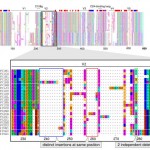 Evolutionary science needs debugging. Apparently, there are a few issues that cannot be resolved with any precision when one asks questions like: What makes a human different from a chimp? Apparently, at the level of genetic sequences, systematic errors creep into any analysis, distorting our ancestry.
Evolutionary science needs debugging. Apparently, there are a few issues that cannot be resolved with any precision when one asks questions like: What makes a human different from a chimp? Apparently, at the level of genetic sequences, systematic errors creep into any analysis, distorting our ancestry.
Now, researchers from the European Molecular Biology Laboratory’s European Bioinformatics Institute have revealed the source of these systematic errors in comparative genetic sequencing and have devised a new computational tool that avoids these errors and provides accurate insights into the evolution of DNA and protein sequences. Their work suggests that sequence turnover is much more common than assumed.
“Evolution is happening so slowly that we cannot study it by simply watching it,” explains Nick Goldman, group leader at EMBL-EBI, “we learn about the relationships between species and the course and mechanism of evolution by comparing genetic sequences.”
At the core of the evolutionary process are random changes in the DNA of all living things, incorrect copying of a single DNA base, or substitution, the loss of a base by deletion, and the inadvertent insertion of a new base. Such changes can lead to functional and structural changes in genes and proteins. If those mutations confer a reproductive advantage on the individual concerned then they will be carried on to the next generation. The accumulation of enough mutations over the course of many generations leads to the formation of new species. Reconstructing the history of these mutation events reveals the course of evolution.
 To compare two DNA sequences, researchers first align them by matching different sequences that share common ancestry. Insertions and deletions are then marked as gaps. This computationally draining process, originally designed for analysing proteins hence its limitations, is usually carried out progressively from several pairwise alignments. However, scientists cannot judge whether a particular length difference between two sequences is a deletion in one or an insertion in the other sequence. For correct alignment of multiple sequences, distinguishing between these two events is crucial, which is where those systematic errors creep in.
To compare two DNA sequences, researchers first align them by matching different sequences that share common ancestry. Insertions and deletions are then marked as gaps. This computationally draining process, originally designed for analysing proteins hence its limitations, is usually carried out progressively from several pairwise alignments. However, scientists cannot judge whether a particular length difference between two sequences is a deletion in one or an insertion in the other sequence. For correct alignment of multiple sequences, distinguishing between these two events is crucial, which is where those systematic errors creep in.
“Our new method gets around these errors by taking into account what we already know about evolutionary relationships,” explains Ari Löytynoja, who developed the new computational tool in Goldman’s lab. “Say we are comparing the DNA of human and chimp and cannot tell if a deletion or an insertion happened. To solve this our tool automatically invokes information about the corresponding sequences in closely related species, such as gorilla or macaque. If they show the same gap as the chimp, this suggests an insertion in humans.”
The team’s work (published in the June 20 issue of Science) suggests that insertions are much more common than previously assumed, while deletion numbers have been overestimated. Now, that tools are being developed to reveal such issues our understanding of evolution can only become clearer.